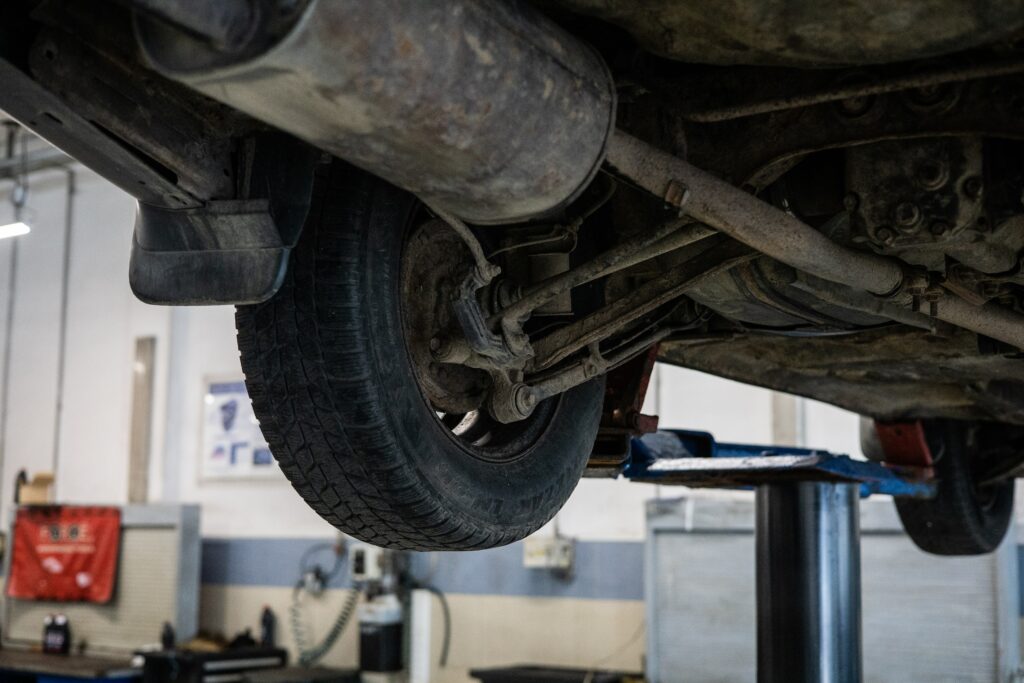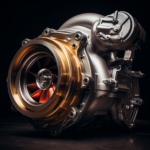Torsion bar suspensions are an effective, adjustable suspension setup that allows for customization of ride feel and height. This suspension setup is perfect for people who like to go off-roading, overlanding, transport heavy cargo, or just like to have the option of adjusting their ride height when they want to.
Understanding the Design and Function of Torsion Bar Suspension
Utilizes a long metal bar that resists twisting forces
At the heart of torsion bar suspension is a long metal bar that acts as a spring. This bar is typically made of steel and is designed to resist twisting forces exerted by the wheels as they encounter bumps or uneven terrain. As these forces are applied to the torsion bar, it flexes and stores potential energy.
The torsion bar is connected to the lower control arm or suspension arm on each wheel. When one wheel encounters an obstacle, such as a pothole or speed bump, it compresses its respective torsion bar. This compression causes the energy stored in the twisted metal bar to be released, absorbing some of the impact and preventing excessive bouncing or jolting.
Transfers energy from the wheels to the chassis
One of the primary functions of torsion bar suspension is to transfer energy from the wheels to the chassis. As mentioned earlier, when a wheel encounters an obstacle, it compresses its corresponding torsion bar. This compression allows for effective energy absorption by converting kinetic energy into potential energy within the twisted metal rod.
By transferring this energy to other components of the vehicle’s suspension system and ultimately to the chassis itself, torsion bars help maintain stability and control during various driving conditions. The stored potential energy in these bars assists in dampening vibrations caused by road imperfections while also reducing body roll during cornering maneuvers.
Adjusted by adjusting bolts or keys to modify ride height
One advantage of torsion bar suspension is its adjustability. The ride height, or the distance between the chassis and the ground, can be modified by adjusting bolts or keys that are connected to the torsion bars. By tightening or loosening these adjustment points, the tension on the torsion bars can be altered, thereby changing the overall ride height.
This adjustability allows drivers to customize their vehicle’s stance and handling characteristics according to their preferences. Whether it’s achieving a lowered profile for enhanced aerodynamics or increasing ground clearance for off-road adventures, torsion bar suspension offers flexibility in fine-tuning ride height.
Connects to the lower control arm or suspension arm
To ensure efficient energy transfer and independent suspension on each wheel, torsion bars are connected to the lower control arm or suspension arm. These arms act as a link between the wheels and other components of the suspension system.
By connecting directly to these arms, torsion bars provide a reliable means of transmitting forces from the wheels to other parts of the suspension system. This connection allows for precise control over wheel movement while also maintaining stability during cornering and braking maneuvers.
Allows for independent suspension on each wheel
Another significant benefit of torsion bar suspension is its ability to provide independent suspension on each wheel. With this design, each wheel can react independently to road imperfections without affecting adjacent wheels.
Independent suspension contributes greatly to overall vehicle performance by improving traction, comfort, and handling. It ensures that disturbances encountered by one wheel do not propagate through neighboring wheels, allowing for better tire contact with uneven surfaces and reducing body roll during cornering.
Advantages of Torsion Bar Suspension in Cars
Excellent Ground Clearance for Off-Road Driving
Having sufficient ground clearance is crucial for off-roading and overlanding. That’s where torsion bar suspension shines the most. This innovative system provides the capability for increased and adjustable ground clearance, allowing your vehicle to conquer even the most treacherous terrains with ease.
With torsion bar suspension, you can confidently navigate through rocky trails and rugged landscapes without worrying about scraping the undercarriage of your car. The design of this suspension system allows for higher ride height, ensuring that your vehicle remains unscathed by obstacles that lie beneath.
Imagine yourself cruising through a dense forest or tackling steep inclines on a mountain trail. Thanks to torsion bar suspension, you can go places where ordinary cars fear to tread.
Easy Adjustability for Different Load Conditions
One of the standout advantages of torsion bar suspension is its easy adjustability, making it a versatile choice for various load conditions. By simply adjusting the torsion bars, you can fine-tune the stiffness and ride height of your car according to the load it carries. Need more stability when hauling heavy items? No problem! Just tweak those bars and enjoy a smoother ride with enhanced handling characteristics.
This adjustability also comes in handy when towing trailers or campers behind your car. With torsion bar suspension, you can maintain optimal control and balance while pulling hefty loads behind you.
Reduced Body Roll for Enhanced Stability During Turns
Have you ever felt like you were on a roller coaster while taking sharp turns? Well, say goodbye to that nauseating sensation with torsion bar suspension. This innovative system minimizes body roll, providing you with enhanced stability and confidence when maneuvering through bends and corners.
When your car enters a turn, the torsion bars resist the body’s tendency to lean excessively, keeping it level and balanced. This not only improves handling but also reduces the risk of rollovers, especially during high-speed cornering.
Reduced Maintenance Compared to Other Suspension Systems
Maintaining a car can be quite an ordeal, but here’s some good news: torsion bar suspension typically requires less maintenance compared to other suspension systems.
Unlike traditional coil springs that can sag over time and lose their effectiveness, torsion bars are known for their durability and longevity. They are designed to withstand heavy loads and constant use without losing their shape or performance.
With this low-maintenance suspension system, you won’t have to worry about replacing worn-out springs or dealing with costly repairs frequently.
Exploring How Torsion Bar Suspension Works
The Twisting Motion: A Spring Mechanism in Action
It’s essential to grasp the concept of the twisting motion. As a vehicle encounters bumps or dips on the road surface, the torsion bar undergoes a fascinating transformation. Unlike other types of suspension systems that rely on coil springs or airbags, torsion bar suspension utilizes a solid metal rod known as the torsion bar.
The torsion bar is connected to the vehicle’s frame at one end and to the wheel assembly at the other end through a component called a reaction lever. This connection allows for rotational movement when forces act upon it. As the wheel encounters an obstacle, such as a pothole or speed bump, it applies pressure to the reaction lever, causing the torsion bar to twist.
Energy Storage and Release: Absorbing Impacts
During this twisting motion, energy gets stored within the torsion bar itself. Think of it as if you were winding up a spring; with every rotation of your hand, potential energy builds up within its coils. Similarly, as the torsion bar twists under pressure from uneven road surfaces, potential energy accumulates within its structure.
This stored energy acts as a spring mechanism for your vehicle’s suspension system. When you hit an obstacle on the road, such as driving over a curb or encountering rough terrain off-road, this accumulated potential energy is released almost instantaneously. It helps absorb impacts and minimizes jolts felt by passengers inside the vehicle.
By transforming kinetic energy into potential energy through twisting motion and then releasing it when needed most, torsion bar suspension ensures smoother rides even under challenging road conditions.
Maintaining Tire-Road Contact: Stability in Motion
In addition to absorbing impacts and providing comfort during rides, another crucial role played by torsion bar suspension is maintaining tire-road contact. This continuous contact between the tires and the road surface is vital for vehicle stability, steering control, and efficient braking.
As the torsion bar twists and releases energy during encounters with obstacles, it assists in keeping all four wheels in contact with the road at all times. This constant connection improves traction, which is particularly crucial when driving on slippery or uneven surfaces.
By maintaining tire-road contact, torsion bar suspension enhances overall vehicle stability and ensures better handling capabilities. It allows drivers to maintain control of their vehicles even in challenging driving conditions.
Components of a Torsion Bar Suspension System
Torsion Bars: The Backbone of the System
Torsion bars are the unsung heroes of a torsion bar suspension system. These long metal bars play a crucial role in providing spring-like resistance against twisting forces. When you hit a bump or encounter uneven terrain, torsion bars flex and absorb the impact, ensuring a smoother ride for you and your vehicle.
Think of torsion bars as giant metal springs that work tirelessly to keep your vehicle’s wheels firmly planted on the ground. As you navigate through rough patches or take corners at high speeds, these robust bars twist and untwist to maintain stability and control. They are designed to withstand immense pressure while offering optimal flexibility.
Suspension Arms: Connecting the Dots
Suspension arms act as the vital link between torsion bars and your vehicle’s chassis. These sturdy components ensure that the energy from the torsion bars is efficiently transferred to other parts of the suspension system. By connecting different elements together, suspension arms enable smooth movement and prevent any unnecessary jolts or vibrations.
Without suspension arms, your vehicle would struggle to handle bumps, dips, or sudden changes in road conditions. These arms provide structural support while allowing for vertical motion of the wheels. Whether you’re maneuvering over potholes or navigating off-road terrains, suspension arms play a pivotal role in maintaining stability and enhancing overall driving experience.
Control Arms: The Wheel Whisperers
Control arms are like whisperers that translate commands from your steering wheel to your wheels’ movements. These vital components connect the suspension system to each wheel, enabling precise control over steering and alignment. They allow for smooth articulation while ensuring optimal contact with the road surface.
When you turn your steering wheel left or right, control arms swing into action, pivoting around their mounting points as they guide your wheels’ motion accordingly. This mechanism allows for efficient cornering and maneuverability, ensuring that your vehicle responds promptly to your every command. Control arms work in tandem with other suspension components to provide a comfortable and responsive ride.
Bushings: Silent Cushions
Bushings may not be the most glamorous part of a torsion bar suspension system, but they play a crucial role in providing cushioning and reducing friction between various components. These small, often rubber or polyurethane-made components act as silent heroes, absorbing vibrations and preventing metal-on-metal contact.
By reducing friction and minimizing noise, bushings enhance the overall comfort of your ride. They also help prolong the lifespan of other suspension parts by acting as shock absorbers. Whether you’re cruising down a smooth highway or traversing bumpy terrain, bushings ensure a quieter and more enjoyable driving experience.
Stabilizer Bars (Optional): The Bodyguard Against Body Roll
While not present in all torsion bar suspension systems, stabilizer bars are optional components that can significantly enhance stability by reducing body roll. Also known as sway bars, these sturdy metal rods connect the left and right sides of the suspension system together.
When you take a sharp turn or encounter uneven surfaces, stabilizer bars come into action. They resist any excessive leaning or rolling motion of the vehicle’s body, effectively minimizing lateral sway. This feature is particularly important during high-speed maneuvers or when navigating winding roads. Stabilizer bars keep your vehicle balanced and improve overall handling for a safer and more controlled driving experience.
The Role of Torsion Bars in Absorbing Impact and Providing Stability
Torsion bars play a crucial role in the suspension system of a vehicle, acting as springs to absorb shocks from uneven road surfaces. These robust bars are designed to distribute the impact evenly across the suspension system, ensuring a smoother and more comfortable ride for both the driver and passengers.
Shock Absorption: A Smooth Ride on Uneven Roads
When driving on bumpy or pothole-ridden roads, torsion bars come into action. Acting as torsional springs, they flex and twist in response to the unevenness of the road surface. This movement absorbs much of the impact that would otherwise be transferred directly to the frame of the vehicle.
Imagine driving down a road filled with potholes without torsion bars. Every time your wheels hit a pothole, your vehicle’s body would experience an abrupt jolt, causing discomfort to everyone inside. However, thanks to torsion bars, this impact is significantly reduced as they act as shock absorbers between the wheels and frame.
Even Distribution of Impact: Maintaining Balance
One of the key advantages of torsion bar suspension is its ability to distribute impact evenly across all four wheels. As each wheel encounters an obstacle or uneven terrain, such as speed bumps or rough patches on the road, torsion bars ensure that no single wheel bears an excessive amount of force.
By providing balanced support for each wheel independently, torsion bars contribute to maintaining stability and preventing unnecessary strain on specific parts of the suspension system. This even distribution helps extend the lifespan of various components while enhancing overall performance.
Stability during Cornering: Resisting Body Roll
During sharp turns or cornering maneuvers, vehicles tend to experience body roll – a lateral shift in weight distribution that can affect stability and control. Torsion bars play a vital role in minimizing body roll by resisting excessive lateral movement.
As the vehicle leans into a turn, torsion bars resist the weight transfer and help keep the body of the vehicle level. This resistance to body roll contributes to improved handling and control, allowing drivers to navigate corners with confidence.
Independent Wheel Movement: Traction and Control
Torsion bar suspension systems offer another advantage – independent movement of each wheel. Unlike other suspension types, such as solid axle or leaf spring systems, torsion bars allow each wheel to react independently to road imperfections.
This independent wheel movement enhances traction by ensuring that all wheels maintain contact with the ground even when encountering uneven surfaces. It also improves overall control by adapting to varying road conditions, providing a smoother ride and reducing the likelihood of skidding or losing grip.
How Torsion Bar Suspension Affects Ride Comfort and Handling
Smooth ride with reduced vibrations
Torsion bar suspension is designed to provide a smooth and comfortable ride by effectively absorbing road vibrations. Unlike other types of suspension systems, torsion bars are known for their ability to distribute the impact of bumps and imperfections in the road across the entire vehicle. This helps to minimize jolts and bumps that passengers would otherwise feel, resulting in a more enjoyable driving experience.
The torsion bar itself acts as a spring, allowing it to flex and twist when subjected to external forces. This flexibility enables the suspension system to adapt and absorb shocks from uneven surfaces. By reducing the transfer of these vibrations into the cabin, torsion bar suspension significantly enhances ride comfort.
Improved handling through reduced body roll
One of the key advantages of torsion bar suspension is its ability to reduce body roll during cornering or sudden maneuvers. Body roll refers to the tilting or leaning motion experienced by a vehicle when turning or changing directions quickly. Excessive body roll can negatively impact handling, making the vehicle feel less stable and responsive.
With torsion bar suspension, the twisting action of the bars helps counteract body roll by providing resistance against lateral forces. This results in improved stability during turns, allowing for better control over the vehicle’s movements. As a result, drivers can enjoy enhanced handling characteristics that inspire confidence on both straight roads and winding curves.
Adjusting ride comfort through preload modification
The preload or stiffness of a torsion bar can be adjusted according to specific preferences or requirements, allowing for customization of ride comfort. By modifying the preload settings, it is possible to fine-tune how much resistance the bars provide against vertical movement.
Increasing preload increases stiffness, which can be beneficial for heavier vehicles or those carrying heavy loads as it helps maintain optimal ride height even under increased weight. On the other hand, decreasing preload offers a softer suspension feel, ideal for maximizing comfort on smoother roads or when driving without a heavy load.
This adjustability allows drivers to tailor their vehicle’s suspension to suit various conditions and personal preferences. Whether seeking a sportier feel with tighter handling or a more relaxed and comfortable ride, torsion bar suspension offers the flexibility to achieve the desired balance.
Enhanced traction on uneven terrain
Torsion bar suspension’s independent design contributes to improved traction, particularly when traversing uneven terrain. Each wheel is allowed to move independently, adapting to the contours of the road or off-road surface.
This independent movement ensures that all wheels maintain contact with the ground even when one encounters an obstacle or dips into a pothole. By keeping each wheel grounded, torsion bar suspension maximizes traction and minimizes wheel slippage. This proves especially beneficial in off-road scenarios where maintaining grip is crucial for maneuverability and stability.
Overall vehicle control and responsiveness
The combination of smooth ride quality, reduced body roll, adjustable preload settings, and enhanced traction ultimately leads to improved overall vehicle control and responsiveness. Torsion bar suspension provides drivers with a heightened sense of connection between themselves and the road.
The system’s ability to adapt to different driving conditions ensures that the vehicle remains stable and predictable regardless of external factors. This results in increased confidence behind the wheel as drivers can better anticipate how their vehicle will respond in various situations.
Torsion bar suspension enhances responsiveness by minimizing delays between driver inputs and actual changes in direction or speed. The reduced body roll allows for quicker weight transfer during cornering, enabling sharper turns while maintaining stability.
Conclusion: Maintenance and Adjustment Tips for Torsion Bar Suspension
Now that you have a better understanding of what a torsion bar suspension is, let’s dive into some essential maintenance and adjustment tips to keep your system running smoothly. By following these guidelines, you can ensure optimal performance, ride comfort, and handling for your vehicle.
Firstly, regular inspections are crucial in maintaining a healthy torsion bar suspension. Check for any signs of wear or damage on the components such as the bars, anchor arms, and adjusting bolts. If you notice any issues, it’s important to address them promptly to prevent further damage.
Secondly, proper lubrication plays a vital role in ensuring smooth operation of the torsion bar suspension. Apply grease or lubricating oil to the anchor arms and adjusting bolts as recommended by your vehicle’s manufacturer. This will help reduce friction and extend the lifespan of the components.
Next, if you find that your vehicle is not sitting level or you’re noticing uneven tire wear, it may be necessary to adjust the torsion bars. Adjusting bolts can be tightened or loosened to modify the ride height and restore balance. However, it’s essential to consult your vehicle’s manual or seek professional assistance for accurate adjustments.
Maintaining proper alignment is crucial for optimal performance of the torsion bar suspension system as well. Regularly check and adjust wheel alignment as per manufacturer recommendations to ensure even tire wear and stable handling.
Lastly, don’t forget about regular tire maintenance. Proper tire inflation levels should be maintained at all times to avoid excessive stress on the torsion bars.
In conclusion, taking care of your torsion bar suspension involves regular inspections, lubrication, adjustments when needed, alignment checks, and tire maintenance. By following these maintenance tips diligently, you can prolong the lifespan of your suspension system while enjoying a comfortable ride with excellent handling.
Aftermarket or Replacement Suspension Parts
I recommend using Tire Rack to buy suspension components. Whether you want to perform the maintenance yourself or just save money on the parts so your mechanic doesn’t upcharge you, Tire Rack is a great place to shop. They guarantee proper fitment for your vehicle by using a program where you can enter the year, model, make, and trim of your vehicle. They also offer a 30-day return policy on unused items and fast free shipping on every order over $50.

Frequently Asked Questions
How often should I inspect my torsion bar suspension?
Regular inspections are recommended every 6 months or whenever you notice any signs of wear or damage.
Can I adjust the torsion bars myself?
While it is possible to adjust the torsion bars yourself, it is advisable to consult your vehicle’s manual or seek professional assistance for accurate adjustments.
What can happen if I neglect maintenance on my torsion bar suspension?
Neglecting maintenance can lead to increased wear and tear, reduced performance, uneven tire wear, and compromised handling. It’s important to address any issues promptly to prevent further damage.
How do I know if my torsion bars need adjustment?
If your vehicle is not sitting level or experiencing uneven tire wear, it may be an indication that the torsion bars need adjustment. Consulting a professional mechanic will help diagnose and resolve the issue accurately.
Can improper alignment affect my torsion bar suspension?
Yes, improper alignment can put additional stress on the torsion bar suspension system, leading to premature wear and reduced performance. Regular alignment checks are essential for optimal operation.
These FAQs provide answers to common questions that can influence purchase decisions and help you make informed choices.





